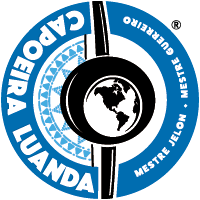The first part of class is always warm ups and stretching to ensure we are ready for movement and to promote flexibility. Once warm, we work on particular moves and sequences, first individually and then often with partners. Towards the end of class, we might work on some music or form a “roda” (circle) in order to play freely and put into practice what we have learned. A student is never put on the spot or forced to do anything they are not comfortable with.
What should I wear to my first class?
When taking your first classes, wear loose fitting exercise clothes that allow you a full range of motion. Comfortable pants for working out and a t-shirt are perfect. Don’t forget to bring a bottle of water so you can re-hydrate throughout the class!
How about shoes?
In our style of Capoeira, most people train barefoot. However, shoes are totally acceptable. We recommend that if you do wear shoes, make sure they are lightweight and flat, with soles that allow you to spin on the ball of your foot. The classes are held in the Rec Center dance studio which has smooth, polished wood floors. For outdoor classes and shows, we all wear shoes.
Do I need a background in Martial Arts/Gymnastics/Dance etc. in order to enjoy Capoeira?
Absolutely NOT. Capoeira is for EVERYONE! We each do what our body allows. Our teachers take into consideration physical limitations, injuries, etc. and provide options to accommodate.
Can I use Capoeira for self-defense?
Capoeira is a beautiful, flowing, dance-like art form, but the basic movements of Capoeira were used by slaves to fight their way to freedom. These movements can absolutely be used in self-defense.
How is Capoeira different from other martial arts?
Because Capoeira was originally fighting disguised as dance, to this day we incorporate musical instruments, traditional songs in Portuguese, Portuguese nicknames for each Capoeirista, to keep the culture and history of Capoeira alive.
Will I get a good workout from Capoeira?
Definitely! Cardio and stamina from the constant movement, resistance training using your own body weight, and flexibility/agility.
Can I lose weight from practicing Capoeira?
Capoeira is a combination of an aerobic and a resistance workout, it is therefore an effective fat burner.
Does Capoeira have belts like other martial arts?
We have cords (ropes) with the following system of colors:
White (Raw Cord) (Aluno): Students begin their Capoeira training at this level. The Corda Crua, translated as Raw Cord, signifies that rather than being seen as inexperienced, students are seen as being full of potential for growth.
Yellow/White (Aluno): Typically this is a cord given to students to welcome them to the world of Capoeira.
Yellow (Aluno): At this level students begin to demonstrate an understanding of the Capoeira game, and have a basic knowledge of the movements, such as kicks and ground techniques, as well as music. Students know the choruses to many songs and are starting to play instruments.
Orange/Yellow (Aluno): Transitional cord.
Orange (Aluno): At this level students have a much deeper understanding of the Capoeira game. They now begin utilizing many different kicks and acrobatic movements. At this level, students are also capable of singing solos during a roda and playing many different instruments.
Blue/Orange (Aluno): Students at this level now fully incorporate a large variety of kicks and acrobatic movements, have a large repertoire of songs, and can play all instruments.
Blue (Graduado): At this level, students earn the title of “Graduado”, which means “Graduated”. In a sense, this is a new beginning for students, a new “Corda Crua”, because, as mentioned before, assessments are based more on teaching ability, which is a new step for students. They must learn to share their own knowledge with other students.
Blue and Green (Graduado): Transitional cord.
Green (Instrutor): At this level, Capoeiristas continue to improve on their skills overall, which now includes the ability to teach. They are very strong in the roda, and are equally as strong when teaching a class. Their strength comes from their ability to incorporate malandragem, or deviousness, into their game. It’s malandragem that gives Capoeiristas their ability to surprise and confuse their opponents.
Green/Purple (Instructor): Transitional cord.
Purple (Professor): To reach this level, Capoeiristas must not only have proven themselves to be skilled martial artists, but also proficient teachers. Professors are regarded very highly, as they have come very far and have devoted their lives to being part of Capoeira. Their malandragem skills continue to increase, since they now have the ability to apply the knowledge they’ve gained over the years to their dealings in the outside world, and vice-versa.
Purple/Brown (Professor): Transitional cord.
Brown (Contra-mestre): Contra-mestre are not only some of the most important figures of their group, but in the world of Capoeira itself. They are the right hand of the Mestres within their group, and are so esteemed and honored that, even at this level, they are respected as Mestres. Formidable players in the roda, Contra-mestre can seamlessly combine all of their skills into a fierce and relentless game.
Brown/Black (Contramestre): Transitional cord.
Black (Mestre): This is the apex for students of Capoeira; the highest and hardest level to achieve. Mestres are legendary for their skill, wisdom, and tact both inside and out of the roda. They have solidified their Capoeira games by consolidating all of the physical skills they’ve learned through their years of training with the cunning and trickery they’ve learned through their life experience. Mestres comprise the top echelon of all Capoeira groups, and it is therefore their right to oversee and supervise the on-goings of the group they lead.
